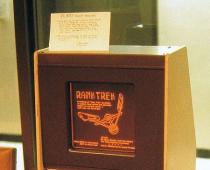CCleaner program
When a user installs many programs, connects UBS media, equipment, launches toys on his PC, all these actions are displayed in the system registry. We can say that the registry is a huge database. The problem is that after deleting/disabling/fixing anything, the configurations are saved in the database, that is, garbage, errors and other defects appear, even, for example, after the program is uninstalled.
Cleaning the system registry in CCleaner
To make Windows 7 work faster, you sometimes need to clear the registry of debris. If we do the cleaning manually, it will take a lot of time. The registry accumulates not tens or hundreds, but thousands of different parameters. CCleaner will help you instantly clean your entire system.
Section - Registry
(Picture 1)
1. Open the program and go to the “Registry” section.
2. Start the scan. If you don’t want to delve into the work, then just click "Search for problems". However, before searching, you can exclude many items:
applications;
fonts;
startup;
help files;
type libraries, etc.
As for backups, this opportunity appears before cleaning. That is, you create a copy of the entire registry so that if an important parameter is deleted, you can easily return it. This is very useful when, for example, you deleted the registration key from a program installed on your computer.

(Figure 2)
3. Analysis of error search results
The analysis itself takes 30 seconds, no more, during this time CCleaner manages to search for broken or unnecessary registry files using our own database. After searching for errors in the registry, the user receives a complete list of problems, data, and their location in the registry. So you can fix problems either manually or through an automatic tool.

(Figure 3)
The cool thing about CCleaner is that it shows you exactly what the problem was before fixing it. For example, the game was not completely uninstalled, and they also offer a solution, most often, this is deleting an unnecessary parameter.

(Figure 4)

(Figure 5)
Based on the results of the test, you will, of course, not see any significant improvements in the performance of the operating system, you just ensured a faster response to make Windows respond to your tasks much faster. In addition, if you did not uncheck any boxes before analysis, the startup system was also cleared, which means that Windows 7 will now boot much faster.
All users of personal computers, sooner or later, have to clean their computer of “garbage”, which accumulates over time and begins to slow down the computer. So today I’ll tell you about what it isregistry cleaning , why clean it, what programs to optimize it with, and what are the benefits of this procedure.
What is the Windows operating system registry?
The Windows registry is a database for storing operating system settings information. To put it simply, the registry stores data about programs installed on the computer and other documents. Computer users are allowed to edit the registry; to do this, simply run the standard editor Regedit.exe or Regedt32.exe. Manually editing the registry can sometimes provide good results in eliminating many errors, but not all ordinary users understand this. Also, when editing the registry, many encounter an error, but this is not a problem, I wrote a separate post about this - where the main cause of this error was, of course, viruses.
Why clean the system registry?
Windows Registry Cleaner- this is essentially one of the procedures. Just recently I talked about it, which, in principle, also helps. To defragment your computer's hard drive, I recommended using programs such as Defraggler and Auslogics Disk Defrag. Well, we will clean the registry using the best “cleaner” - CCleaner . I have already spoken about this wonderful program more than once. Today I will make a detailed review of this utility, explain how to use it and what settings need to be made to clean the registry.
So I explained that by cleaning the registry you can, in principle, increase the performance of your computer, but due to what, perhaps many did not understand. But in fact, everything is simple. When you install programs on a computer, they leave their branches in the registry, and it turns out that when you uninstall, there are extra branches (or links) to programs that prevent the computer from working smoothly, and cleaning the registry using the same free CCleaner utility allows free up unnecessary branches that interfere and slow down the computer.
Now I hope it’s clear that the registry needs to be cleaned at least sometimes. Now you can go to the CCleaner registry cleaner program. First, of course, you need download CCleaner, then install, there should be no problem with the installation, everything is as simple as when installing other programs. Next, launch the utility by double-right-clicking on the shortcut.
Perhaps after the first launch the program language will be English; to change it, you need to go to the “Options” -> “Settings” tab and in the drop-down menu opposite “Language” select the desired language.



After the analysis is completed, and this can be recognized by the green strip with the percentage of the analysis completed - “100%” and the “Fix” button becomes active, you need to click on this very button.
Next, a window appears in which you must agree or disagree to save the backup copy. I recommend that you save, although it rarely happens that something goes wrong after cleaning the registry with CCleaner, but nevertheless, it’s better to take care of it right away than to regret it later. To do this, simply click “Yes” when this window exits.

You will be asked to save the file; to do this, you need to select the location where the backup copy will be saved, by default it is in “Documents”.

That's it, the backup copy has been saved, now if problems arise with programs, games or other “lags” on the computer, you can simply run this saved backup copy and the registry will be restored to its previous state. But that’s not all, after we agreed or refused the backup, the following window appears:

Where you need to click the “Correct marked” button. After this, the word “Fixed” will appear. You can close the window.

That's it, we've sorted out cleaning the registry. But CCleaner has other cool features that will help increase your computer's performance. For example, in the first tab “Cleaning”, there is an item “Cleaning free space”, where you can check the box, click “Analysis” and then “Cleaning”. With this item, the cleaning operation takes quite a long time, but if you just want to speed up the computer a little by clearing garbage, then you can uncheck this item, leaving all the others unchecked.
Also, by going to the "Service" tab, you can see convenient functions, for example, "Startup", by removing unnecessary programs (they increase the OS boot time), you can reduce the system boot time, we have already talked about this, so use this function.
This concludes the article about optimizing your computer using cleaning the system registry Windows program CCleaner. Best wishes.
Any current version of Windows - 7, 8 and, of course, 10 includes and constantly uses a special settings database called the registry. It stores thousands of parameters of both the OS itself and applications installed by the user. If the system has been installed long enough, then over time a decent number of incorrect, “garbage” entries in the registry will inevitably accumulate. It is advisable to get rid of such records in a timely manner, especially on not the fastest machines. The program does an excellent job of cleaning the registry, and after it works, the Start or language bar will not fall off.
The application conventionally divides possible registry errors into 15 types, including:
- missing shared dlls
- invalid file extensions
- type libraries
- and others
To start analyzing the registry, you need to click the “Search for problems” button and after a few seconds the program will present to your attention usually a very impressive list. The results table consists of three columns - “Problem”, “Data”, “Registry section”. This information is enough to examine each entry in detail either superficially or directly in regedit. If necessary, you can add the necessary data to the exclusion list. Let's look further at fixing entries using the first type, “Missing Common DLLs,” as an example.




We select this type and click on “Search for problems” - CCleaner finds on the tested computer 24 incorrect, from its point of view, registry keys. To start the cleaning procedure, click on the “Fix...” button in the lower right corner. At this stage we have 2 options:
- fix each problem step by step if you need the maximum level of control
- select a mass correction using the “Fix marked” button
Is it safe to delete registry entries?
One of the main advantages of CCleaner as a cleaner is that it is quite difficult to harm the system. There is always a chance to delete something unnecessary, but it is extremely insignificant and will definitely not affect important Windows settings. Some of our users may say that the registry cleaning procedure itself is not necessary. If you have a modern computer, especially with an SSD on board, then yes, you can completely do without such optimizations.
For novice users, it may seem like a complicated and lengthy process. But there is nothing complicated here! Craftsmen have long developed special programs that will find almost all the “garbage” in your registry, and all you have to do is confirm the removal of this pile of unnecessary junk. So cleaning the registry is very easy!
Before we start reviewing registry cleaning programs, let me give you a little theory. Let's consider in general why to clean the registry and what it is, what its structure is.
The registry is a database in the Windows system. This database stores hundreds of parameters and settings of the operating system, installed programs and other data. Let's touch briefly on the topic of these programs that are stored in Windows system registry.
So, almost every program that we install on our computer enters a determination of the amount of data into the registry. But after removing this program, the data remains. It only deletes the files of its program, and not all of them, and leaves everything that it has entered in the registry in most cases. So imagine how this registry database can grow if you install and remove programs for a long time. But this is what happens, from time to time we use some on our computer, and some .
That is why you need to clean the registry once a month. Moreover, a “littered” registry database can cause poor performance. This, of course, is not a decisive factor why it might, for example, but I still recommend keeping the registry clean and tidy.
The registry has several main sections:
HKEY_CLASSES_ROOT;
HKEY_CURRENT_USER;
HKEY_LOCAL_MACHINE;
HKEY_USERS;
HKEY_CURRENT_CONFIG.

After downloading, install the program on your computer and run it. Now I will explain to you how to correctly CCleaner clean registry.
We need to go to the “Registry” tab, make sure that opposite all the items in the parameter “ Registry integrity“check all the boxes and click the “Search for problems” button.

When the program completes the analysis, it will offer to fix the problems found. Click the "Fix" button.

We will be prompted to make backup copies of the changes we have made. As I understand it, this is just in case if after running the program the registry starts to not work correctly. I completely trust the program, so I click “No”.

We confirm the correction of the problems found, at the discretion of the program, by clicking “ Correct marked" The program will remove unnecessary things and try to fix what happens.

Do this operation to find and remove problems in the registry until everything is fixed.

Using this fairly simple utility, you can easily find what deleted programs left behind and clean the registry in automatic mode.
Of course, not always registry cleaning leads to the desired result, for example, the computer is still not stable, glitches or slows down. In this case, you need to look for a reason elsewhere. But an operation to clean the registry is still necessary from time to time.
It is also advisable to understand the registry so that, if necessary, you can not only delete something unnecessary, but also restore it, for example, after a virus attack. But that's a completely different story.
That's all for today, I hope my instructions on how to clean the registry will be useful to you. And most importantly, do not forget to scan and find problematic entries in this huge database once a month using the CCleaner program.
The registry cleaning is completed, I wish you success in completing this operation too!
is a popular utility, the presence of which on a computer will be useful to any computer owner. Its purpose is to optimize the device and speed up the operation of the device. Using the program, you can remove unnecessary software and system junk, as well as perform a number of other useful tasks.
Registry
The PC system registry is a hierarchically built database containing information and settings for software, hardware, user profiles, etc. Most changes that occur on the computer are saved in this partition.
When you delete a program, its data is not completely removed from the registry memory; partial information about it remains. The same pieces of data remain when you change file paths, configure Windows services, adjust startup, and also when performing many other actions. These partial data accumulate over time and clog the system, thereby slowing down the PC and significantly degrading its performance.
Analyzing and cleaning the registry with the CCLeaner utility
To check the registry for errors, you need to run the CCleaner utility and go to the section of the same name.

To start analyzing your computer, click on the “Search for problems” button at the bottom of the window. The search process will start. In the column on the left you can see what errors the application is looking for and cancel or add the necessary ones.

After the check is completed, a list of detected errors will appear on the screen.

The user can select all found problems or only some of them. To fix them, click “Fix Selected”. The system will offer to save the current version of the registry as a backup in order to be able to restore it if any failure occurs as a result of erroneous actions.

If you click on the “Yes” button, a window will appear on the screen to select the folder in which the initial version will be placed.

Next, a window with error correction will appear on the screen. In it you can view the detected problems by clicking on the arrow buttons on the left, and also fix each one in turn or all at once by clicking on one of the buttons of the same name.

Once the problems are resolved, a notification will appear indicating that no problems were found.

Thus, cleaning the registry using CCleaner is very easy, and given the simple and user-friendly interface, even an inexperienced user can easily handle it.
Conclusion
Knowing how to clean the registry using CCleaner is recommended for all users. This procedure allows you to optimize your computer and improve its speed and performance. The process of action is very simple and will not cause difficulties even for a person who has never encountered solving such problems.
- In contact with 0
- Google+ 0
- OK 0
- Facebook 0







